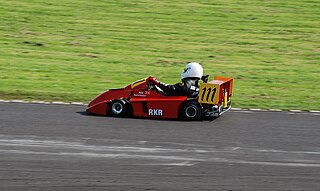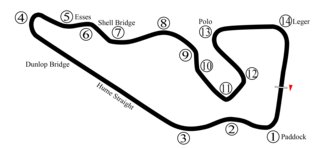
Superkart is a form of motorsport road racing in which the class is a racing vehicle sized like a go-kart but with several characteristics more strongly associated with open-wheel racing cars.

Australian Formula 2, sometimes abbreviated to AF2 or ANF2, is a "wings and slicks" formula racing category in Australia. The category is one of Australia's oldest, dating back to 1964. The current format of AF2 was introduced in 1978. Brian Shead of Cheetah Racing Cars and Garrie Cooper of Elfin Racing Cars were largely responsible for the development of the format, which was devised to suit the needs of Australian drivers, most of whom had little or no sponsorship and had to bear the costs of racing out of their own pockets.
Frank Matich was an Australian racing car driver. A highly successful motor racing competitor in the 1960s and 1970s, Matich built his own range of Matich sports cars and open wheel cars, mainly to support his own career, but some cars found success with other drivers. In these and other makes he won five Tasman Series races, two Australian Grands Prix, the 1972 Australian Drivers' Championship and a number of other Australian motor racing titles.
The 1975 Australian Drivers' Championship was a CAMS sanctioned Australian motor racing title open to Australian Formula 1 cars and Australian Formula 2 cars. The championship winner was awarded the 1975 CAMS "Gold Star". The title, which was the nineteenth Australian Drivers' Championship, was won by John McCormack driving an Elfin MR6 Repco-Holden.
Formula Pacific was a motor racing category which was used in the Pacific Basin area from 1977 to 1982. It specified a single-seat, open-wheeler chassis powered by a production-based four-cylinder engine of under 1600cc capacity. The formula was based on Formula Atlantic, with provision made for the use of Japanese engines. The category was superseded in 1983 by Formula Mondial, which was devised by the FIA to replace both Formula Atlantic and Formula Pacific.
The 1982 Australian Grand Prix was a motor race held at the Melbourne International Raceway, formerly Calder Raceway, in Victoria, Australia on 8 November 1982.

The BRM P261, also known as the BRM P61 Mark II, is a Formula One motor racing car, designed and built by the British Racing Motors team in Bourne, Lincolnshire, England. The BRM P261 was introduced for the 1964 Formula One season, and its design was an evolution of Tony Rudd's one-off BRM P61 car of 1963. The P261 had a relatively long racing career; variants of the car were still being entered for Formula One World Championship Grands Prix as late as 1968. During the course of their front-line career BRM P261s won six World Championship races, in the hands of works drivers Graham Hill and Jackie Stewart, and finished second in both the Drivers' and Constructors' Championship standings in 1964 and 1965. Stewart, Hill and Richard Attwood also used works P261s to compete in the Tasman Series in 1966. The BRMs dominated, with Stewart winning four, Hill two, and Attwood one of the 1966 Tasman Series' eight races. Stewart also won the title. The works-backed Reg Parnell Racing team returned in 1967 with Stewart and Attwood, where Stewart added another two wins to his tally. In terms of races won and total Championship points scored, the P261 was the most successful car in BRM's history.
The 1986 Australian Drivers' Championship was a CAMS sanctioned Australian motor racing title for Formula Mondial racing cars. It was the 30th Australian Drivers' Championship. The championship winner was awarded the 1986 CAMS Gold Star.

Australian Formula 1 (AF1) was a motor sport category for open-wheeler racing cars which was current in Australia from 1970 to 1983.

The 1979 Australian Grand Prix was an open-wheel racing car race held at Wanneroo Raceway north of Perth in Western Australia, Australia on 11 March 1979.
The 1973 Australian Drivers' Championship was a CAMS sanctioned national motor racing title open to drivers of Australian Formula 1 and Australian Formula 2 cars. It was the seventeenth Australian Drivers' Championship and the championship winner was awarded the 1973 CAMS "Gold Star".
The 1974 Australian Drivers' Championship was a CAMS sanctioned national motor racing title for drivers of Australian Formula 1 and Australian Formula 2 racing cars with the championship winner awarded the 1974 CAMS "Gold Star".
A 1979 Australian Drivers' Championship was a CAMS sanctioned national motor racing title for drivers of Australian Formula 1 racing cars. The championship winner was awarded the 1979 CAMS Gold Star. The title, which was the 23rd Australian Drivers' Championship, was won by Johnnie Walker, driving a Lola T332.
The Australian 1½ Litre Formula was a motor racing category which was current in Australia from 1964 to 1968. The formula specified racing cars with four-cylinder unsupercharged engines using commercially available fuel and limited to 1500cc capacity. It occupied the second tier in Australian formula car racing, below the Australian National Formula and above Australian Formula 2 (1100cc) and Australian Formula 3 (1000cc).

The 1970 Australian Grand Prix was a motor race held at Warwick Farm Raceway in New South Wales, Australia on 22 November 1970. The race, which was the thirty fifth Australian Grand Prix, was open to Formula 5000 cars, 2.5-litre Australian Formula 1 cars and Australian Formula 2 cars. For the first time since 1956, the race was not a round of either the Australian Drivers' Championship or the Tasman Series.

The 1971 Australian Grand Prix was a motor race held at Warwick Farm Raceway in New South Wales, Australia on 21 November 1971. It was open to Racing Cars complying with either Australian Formula 1 or Australian Formula 2 regulations.
The 1975 Australian Grand Prix was a motor race for Australian Formula 1 and Australian Formula 2 racing cars, held on a very wet track at the Surfers Paradise International Raceway in Queensland, Australia on 31 August 1975. It was the fortieth Australian Grand Prix and was also Round 1 of the 1975 Australian Drivers' Championship.
The 1980 Australian Drivers' Championship was a CAMS sanctioned Australian motor racing title for drivers of Australian Formula 1 racing cars. The winner of the championship, which was the 24th Australian Drivers' Championship, was awarded the 1980 CAMS Gold Star.
The 1971 Australian Drivers’ Championship was a CAMS sanctioned motor racing title open to Australian Formula 1 and Australian Formula 2 racing cars. It was the fifteenth Australian Drivers' Championship and the first to feature cars complying with a new for 1971 Australian Formula 1 which permitted cars with production based V8 engines of up to 5 litre capacity or racing engines of up to eight cylinders and up to 2 litre capacity. The championship winner was awarded the 1971 CAMS Gold Star and the title of Australian Champion Driver.
The Mildren name was used on a series of racing vehicles constructed for, or acquired by, Australian racing team owner Alec Mildren during the 1960s and early 1970s.






